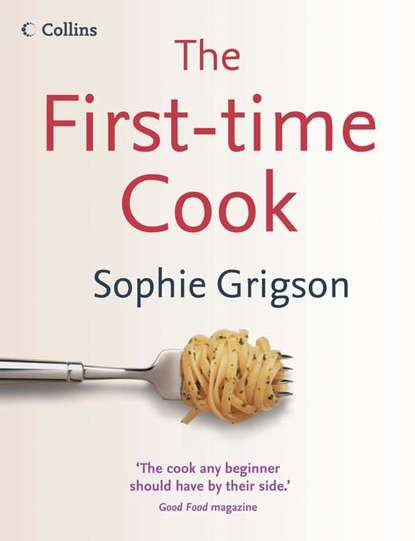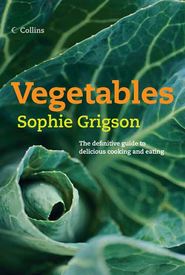По всем вопросам обращайтесь на: info@litportal.ru
(©) 2003-2024.
✖
The First-Time Cook
Настройки чтения
Размер шрифта
Высота строк
Поля
Ripe figs are tender and fairly soft. Pick them out carefully, avoiding any that are showing patches of brown. Handle them reverently, and place them side by side in a paper bag, settling the bag on top of the rest of your purchases as ripe figs are easily squashed. One or two figs per person is fine.
To serve the melon, cut into eight wedges. Scrape out the seeds and discard. Arrange the slices on individual plates and drape two or three thin slices of Parma ham (or jamón serrano) over each serving.
With the figs, nip the hard stalk tip off each one, then quarter, cutting down towards the base, but stopping just short of it, so that the quarters stay together. Splay them out slightly like the petals of a flower. Place on individual plates, and arrange two or three thin slices of Parma ham (or jamón serrano) alongside them on each plate.
Grilled Goat’s Cheese Salad
Now something of a bistro classic, this is still a great way to start a meal, but does require a brief spell of last-minute work in the kitchen. Keep this to a minimum by preparing everything in advance, so that it’s all ready to go. Choose small drum-shaped goat’s cheeses for this – the sort with a soft, white rind.
For each person you will need a handful of mixed salad leaves (I favour a mix of rocket and spinach, but the choice is entirely yours), about
/
tablespoon of a good vinaigrette (see page 189), a
/
goat’s cheese, a small sprig of rosemary or parsley, a trace of oil (olive or sunflower) and some good (walnut) bread.
Preheat the grill thoroughly and line the grill rack with foil. Arrange the
/
cheese cut-side up on the foil. Brush the cut side with a little oil, then slide under the grill until browned. Meanwhile, toss the salad with the vinaigrette and divide between plates. Top each salad with a sizzling, browned
/
goat’s cheese and finish with a sprig of herb. Serve immediately with toast.
Guacamole
Quick and easy to prepare, guacamole makes a brilliant starter served with warmed pitta bread or tortilla crisps. Alternatively, use it as a sort of relish to serve with grilled fish or meat, or roll up with chicken and peppers in a ‘fajita’ (see page 108).
If you use the smaller Hass avocados you will need three, but with larger avocados two will suffice. The avocados must be ripe and buttery for guacamole.
Serves 4 as a starter
2 tomatoes
1–2 fresh red chillies
a handful of coriander leaves
2–3 ripe avocados
1/2 red onion, peeled and finely diced
juice of 1 lime
salt and pepper
1 Deseed and finely dice the tomatoes. Deseed (depending on strength) and finely chop the chillies. Chop the coriander. Skin the avocados, and remove the stones.
2 Working quickly, roughly mash the avocado flesh with a fork in a bowl, then mix in all the remaining ingredients. Taste and adjust flavouring, adding more lime if needed. Cover the surface with clingfilm to exclude as much air as possible, thus diminishing the inevitable browning of the avocado. Chill.
3 Bring back to room temperature before serving, then stir and scoop into a clean serving bowl.
Eggs
A decent meal is never far away if you have a stash of eggs in your kitchen. And if you think egg dishes are boring, you’d better revise your thinking right now. An omelette, for example, is an extraordinary vehicle for any number of other ingredients from the minimalism of a grating of Cheddar to the Mediterranean delights of a frittata. The humble fried egg is given a new lease of life with a spot of chilli and garlic, while scrambled eggs take to the fresh zing of citrus juice with consummate ease. One of the best of all egg and cheese combinations, needing just a little butter and flour for substance, is the wicked French gougère, a gorgeously indulgent, gooey cheese pastry that I often knock up for supper or a light lunch. The great thing about all of these simple dishes is that you can tailor them to your own requirements – once you get the basic principles sorted, the imagination can take over (even if it is only to the extent of using up the odds and ends left in the back of the fridge).
Buying Eggs
Eggs are no longer just mere eggs. Oh no. Nowadays there is a bewildering series of choices to be made when buying eggs: four-grain, barn-fresh, perchery, free-range, organic, Colombian this, and something else that. In fact, buying eggs is not half as confusing as it may first seem when you are facing the high-stacked egg shelves. Ultimately there are really only three critical choices to make: size, the well-being of the laying birds, and freshness.
Size
Eggs are sorted into size bands according to weight: extra large (more than 73g), large (63–73g), medium (53–63g) and small (less than 53g). All the eggs used in testing recipes for this book were large, so if you want to be sure of getting a good result with my recipes, these are the ones to go for. When you are using other cookbooks, particularly if you are baking cakes, it is worth checking the beginning of the book, where there should be a short section telling you what size eggs are to be used, as well as other useful basic cook’s information.
Happy Chooks
By the year 2012, the very worst space-depriving cages for egg-laying chickens will have been banned in the EU. About time too, for they are grim and deeply objectionable. Hard to believe that a nation of so-called ‘animal-lovers’ could have let them exist for so long. Meanwhile, unless you really don’t care one iota about animal welfare, pay the few extra pence to buy free-range eggs. The law guarantees that the chickens that lay these eggs at least have continuous daytime access to outdoor runs. In other words, they can peck around and stretch their wings, even if they don’t live in quite the idyllic circumstances one might imagine. Organic eggs are by definition free-range.
Freshness
Crack open a perfectly fresh egg on to a saucer and the yolk stands proud above the white, which clings thickly around it. In an older egg the yolk is flatter and flabbier, while the white is more liquid and spreads in a dilute fashion around the saucer. Luckily you don’t have to crack open each egg to ascertain its age. Look on the box instead, where you will find a ‘best before date’. The eggs were laid 21 days, in other words three weeks, before this date.
For some cooking methods (poaching in particular) ultra-freshness is critical, whilst for others (e.g. boiling) a small scrap of maturity is a positive boon.
Salmonella
The doom-laden spirit of salmonella contamination still lingers on in many people’s minds. The truth is that these days the chances of developing salmonella poisoning from semi-cooked or raw eggs is verging on negligible. That time-honoured hazard of falling under a bus is far, far more likely to happen to you than a spot of salmonella sickness.
All eggs that are stamped with the ‘lion’ symbol (which represents the Lion Quality Mark) come from flocks of chickens that have been vaccinated against salmonella, and are regularly checked to make doubly sure they are clean. If you are buying wonderful extra-free-range eggs from a local farmer, then the likelihood is that his or her flock has also been vaccinated, but if in any doubt, just ask.
Salmonella bacteria are killed by high temperatures, so eggs that are hard-boiled or cooked thoroughly in, say, a cake batter cannot possibly cause any harm. Many of the most delicious ways of cooking eggs, however, demand that they are semi-cooked, with the yolk still runny and this is where, in the very, very unlikely event that they are infected, the problem lies. For most healthy people, the worst that could happen is a nasty bout of stomach upset and diarrhoea, but it is not worth risking even this extraordinarily unlikely event with anyone susceptible to illness. In other words, the elderly, invalids, pregnant women and very young children should all steer clear of semi-cooked or raw eggs. End of scare stories.
The Importance of Colour
None. The colour of the eggshell is totally irrelevant and tells you nothing about the inside or the way it was produced. Even more surprisingly, the colour of the yolk isn’t much to go on, either. A deep, rich, almost orange hue might suggest a grain-rich diet for its mother hen, but it may just as well indicate the inclusion of dyestuffs in the feed. Appearances can be deceptive.
Storage
In an ideal world, you would keep your eggs in a cool larder, temperature around 15°C or less. Oh? You don’t have a cool larder where you live? How very awkward of you! You’ll just have to keep your eggs where most people store them: in the fridge. It’s the second best option and it’s done me fine for the past twenty something years, so I don’t think there’s any need for concern. Try to remember to get them out of the cold and into the warmth of the kitchen 15 minutes or so before cooking, particularly if you are boiling or poaching them – again, counsel of perfection, but easier to achieve than the cool larder.
Separating Eggs
Separating the yolk and white of an egg is essentially an easy process, but it may nonetheless take two or three attempts to get it right. So make sure that you have a couple of eggs in reserve, just in case. Fresher eggs (up to a week old) are easier to separate than older ones.







